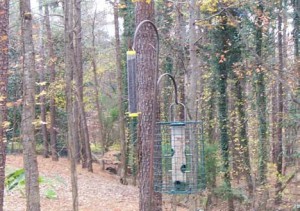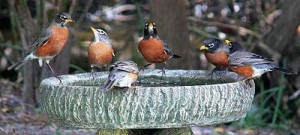 I feed birds year round but I’m sure some “experts” will disagree with this practice. Providing food and water attracts a variety of birds that delight me with their presence, particularly in the winter. Remember that you will be taking on the
I feed birds year round but I’m sure some “experts” will disagree with this practice. Providing food and water attracts a variety of birds that delight me with their presence, particularly in the winter. Remember that you will be taking on the
responsibility for feeding these birds throughout the winter and early spring. They will come to depend on you since their natural food supply is limited.
There are many different types of feeders on the market. Plastic, steel, or glass feeders are best since they are easy to clean. Feeders with porous surfaces, such as wood or clay, can be difficult to clean and can grow algae and fungi that may be harmful to some birds. Diseases such as salmonella can spread at feeders, especially where seeds and droppings mix. Ground-feeding birds, such as doves and finches, are especially vulnerable. To reduce the risk of disease, clean your feeders at least once a year with a 10 percent bleach solution – one part bleach to nine parts water. Small feeders are
desirable since they empty out quickly and reduce the chance of wet, spoiled seeds.
Do not leave your cat outside even it has a bell on its collar. There are about 100 million domestic and feral cats in North America, and these kill about several hundred million birds each year. Cats kill about 30 percent of birds found dead at feeders. Cats are such stealthy hunters that they can stalk and pounce on prey without jingling the bell on their collar. By keeping your cat indoors, you’ll not only protect birds but also keep the cat safe from disease, traffic, and fights with neighborhood pets and wildlife.
Unless you love squirrels, avoid hanging feeders from trees and eaves. Place them on isolated poles at least five feet off the ground and as far as possible from your house and nearby trees and tall shrubs. Keep in mind that squirrels can leap as far as six feet. Attach to the feeder pole either an inverted cone with at least a 13-inch diameter, a special squirrel-deterring dish with a 15-inch diameter, or a PVC pipe or stovepipe that’s 6 inches in diameter and 18 inches long. Protect feeders suspended from a horizontal wire by threading old records, compact discs, or plastic soda bottles on the wire on each
side.
 Water is also needed for drinking and bathing. I am fortunate in that I have both a pond and a creek that seldom freeze over. I do, however, have one birdbath and it is located away from the feeders to keep the water clean. Rinse the birdbath daily and clean it weekly with a 5-10% solution of chlorine bleach. In the winter, never add antifreeze or other chemicals to the water.
Water is also needed for drinking and bathing. I am fortunate in that I have both a pond and a creek that seldom freeze over. I do, however, have one birdbath and it is located away from the feeders to keep the water clean. Rinse the birdbath daily and clean it weekly with a 5-10% solution of chlorine bleach. In the winter, never add antifreeze or other chemicals to the water.
Feed the birds more often at times of high stress, such as during temperature extremes, nesting season, and migration. Definitely feed in late winter and early spring when natural seed sources are depleted.
Birds are attracted to feeders that they feel are safe. Make sure that there is cover nearby to which birds can escape from predators, like my neighbor’s cat. Place ground-level feeders in open areas so that predators cannot sneak up on unsuspecting birds.
Different birds have preferences as to what level they like their food served. Mourning doves, sparrows, towhees, and juncos like to feed at ground level. Cardinals, finches, and jays prefer table level feeders; whereas titmice, goldfinches, and chickadees prefer hanging feeders. Of course, woodpeckers, nuthatches, and wrens prefer tree trunk feeders.
Bird feeding does not necessarily give instant gratification so be patient. When a feeder is first placed outdoors, it may take several weeks before the birds discover it. Depending on the type of seeds you offer, the number of birds at the feeder may increase or decrease. To maximize the number of species that visit your feeders, offer a variety of food and offer it at different heights.
The following is a selection of seeds that attract a wide variety of birds. I store all my seeds in roof ratproof metal containers in the garage.
Black oil sunflower seeds: These seeds are the steak and potatoes of the bird world. Don’t get the grey-and-white sunflower seeds sold as people food. Black sunflower seeds are higher in oil content, softer shelled, and cheaper. These seeds attract cardinals, woodpeckers, blue jays, goldfinches, finches, chickadees, and titmice. Use very sturdy, hanging feeders. Squirrels and raccoons like to visit this type of feeder.
Niger: Niger (PC spelling: Nyger, Nijer, Nyjer) has replaced thistle as the most popular seeds to feed goldfinches. Niger is a black seed that is very tiny and light but very expensive. Buy a hanging tube with tiny holes especially designed for Niger (I found mine in Kroger’s). I hang mine where I can see it from inside my house.
Safflower seeds: Safflower is a white seed that is slightly smaller than the black sunflower seed. It is extremely bitter and squirrels don’t like it. Neither do grackles, blue jays, or starlings. Chickadees, titmice, and downy woodpeckers eat it with abandon.
White millet: Millet is the cheapest seed around and is available at many stores. Scatter it on the ground for sparrows, juncos, and mourning doves. This will also attract squirrels and raccoons.
Cracked corn: Place it in a feeder away from your regular birdfeeder. It will lure away squirrels, sparrows, blackbirds, jays, and doves. Placed on the ground, it will also attract deer, turkeys, and, if your lucky, a few reindeer at Christmas.
 Good seed mix: In general, it will have a large amount of sunflower seed, cracked corn, white millet, and perhaps some peanut hearts. Junk mixes contain wheat, red millet, dyed canary seed, and lots of filler. It is not a bargain. Buy seeds from specialty bird stores or hardware/feed stores.
Good seed mix: In general, it will have a large amount of sunflower seed, cracked corn, white millet, and perhaps some peanut hearts. Junk mixes contain wheat, red millet, dyed canary seed, and lots of filler. It is not a bargain. Buy seeds from specialty bird stores or hardware/feed stores.
Suet: Birds love suet. It is solid fat rendered from beef or venison. Birds need this concentrated energy source in the winter. Always hang suet cakes so as to not attract mammals. Although suet can be placed in plastic mesh bags that are used for onions, the method can be harmful to small birds if the mesh tears and they can become tangled in the mesh. There is no evidence that suet puddings are more attractive to birds than chunks of suet.
Homemade suet pudding: Making “suet pudding” can be an indoor project for all ages. When working with children, make sure an adult supervises the project so no one gets burnt. You will need the following supplies:
- Small bowl
- Selection of birdseed, nuts and fruit, bread
- Bacon fat, lard or shortening
- Small saucepan
- Small plastic container (a sandwich container is ideal)
 Fill a small bowl with birdseed, nuts, small chucks of apples, cranberries, bread and anything else you think birds might enjoy. Mix everything together. Transfer to a small plastic container. Here is where an adult comes in handy. Melt about ½ c. of fat or shortening in saucepan and pour over mixture in the small plastic container. Leave it in a cool place to set and hardened. When the fat has hardened, carefully pull it out of the plastic container. Your “suet pudding” is ready to sit in a suet basket, on a feeder tray or table.
Fill a small bowl with birdseed, nuts, small chucks of apples, cranberries, bread and anything else you think birds might enjoy. Mix everything together. Transfer to a small plastic container. Here is where an adult comes in handy. Melt about ½ c. of fat or shortening in saucepan and pour over mixture in the small plastic container. Leave it in a cool place to set and hardened. When the fat has hardened, carefully pull it out of the plastic container. Your “suet pudding” is ready to sit in a suet basket, on a feeder tray or table.
Peanut butter blends: Combine a mixture of peanut butter and cornmeal. This not only stretches the expensive peanut butter but also makes this sticky treat easier for the birds to swallow. Pack peanut butter-cornmeal blends and/or suet puddings into the crevices of large pinecones or into one-inch-diameter holes drilled into logs. Hang the pinecones or logs from poles near other feeders, from trees, or from a wire stretched between trees. Avoid feeding suet pudding or peanut butter blends when temperatures climb into the 80-degree range; it turns rancid and drippy and may damage feathers.
Pine Cone/Sweet Gum Ball Bird Feeder: You’ll need wax paper, pinecone or sweet gum balls, wire, peanut butter, butter knife, and birdseed.
Spread the peanut butter inside the openings all around the center and bottom of the cone or ball and fill up the spaces. Spread birdseed of your choice on the wax paper. Take the cone or ball and roll it in the birdseed so that the seeds stick to the peanut butter all around the outside. You may also want to sprinkle seeds inside any openings.
Measure your wire to hang down from a branch of a tree or bush so that it is far enough from the branch to keep any squirrels from eating your feeder. Tie your wire to the top of the pinecone or sweet gum ball and then to the tree branch. Watch and record who comes to visit your cone feeder this winter.
| BIRDFEED CHART | |||
| Blackbirds, starlings | Cracked corn, millet, wheat, table scraps, baked goods, suet | Juncos, towhees | Millet, sunflower, cracked corn, peanuts, baked goods, nutmeats |
| Blue jays | Peanuts, sunflower seeds, suet, meat scraps, cracked corn, baked goods | Mockingbirds, catbirds, Thrashers | Apple halves, chopped fruits, baked goods, suet, nutmeats, millet, soaked raisins, sunflower hearts |
| Cardinals, grosbeaks | Sunflower seeds, safflower seeds, cracked corn, millet, fruit | Nuthatches | Suet, sunflower seed, peanut kernels, peanut butter |
| Cedar waxwings | Berries, chopped fruits, canned peas, soaked raisins | Robins, thrushes, bluebirds | Suet, berries, baked goods, chopped fruits, soaked raisin, nutmeats, sunflower seeds |
| Chickadees, titmice | Peanut kernels, sunflower, suet, peanut butter | Sparrows | Millet, sunflower seeds, black oil sunflower seeds, cracked corn, baked goods |
| Doves | Millet, cracked corn, wheat, niger, sunflower, baked goods | Woodpeckers | Suet, meat scraps, sunflower seed, cracked corn, peanuts, fruits |
| Finches | Thistle, sunflower hearts, black oil sunflower seed, millet, canary seed, fruits, peanut kernels, suet | Wrens | Suet, peanut butter, peanut kernels, bread, fruit, millet |


